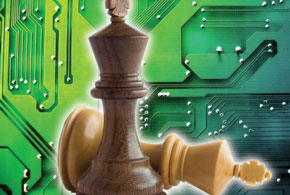The consumerization of IT has swept over the enterprise and changed the way businesses approach hardware, software and other technology systems. While that trend isn’t likely to disappear anytime soon, there’s a growing countertrend: “re-enterprization.” In other words, companies are approaching technology in a way that complements and sometimes sidesteps consumerization, argues Paul Sallomi, vice chairman and U.S. technology leader for Deloitte. Here’s how he sees the environment evolving, particularly as the Internet of things (IoT) takes shape.
Baseline: What exactly is the “re-enterprization” of IT about?
Paul Sallomi: For the last decade, there’s been quite a trend of consumer-led adoption of new technologies. Think about large touch screens, smartphones, and tablet computers. It was more the consumer that was the early adopter. Although we’re not seeing any slowdown in consumer adoption, the pendulum seems to be swinging back to a certain extent—or, at least, we’re seeing a world where the consumer doesn’t always lead the way.
Baseline: Can you provide a few examples?
Sallomi: Smart glass is one example. Initially, there were predictions that we would see significant waves of consumption in the consumer space. Instead, we’re seeing the rise of enterprise-based applications for hands-free use and augmented reality displays—particularly in the areas of security, medical, materials handling and warehousing.
3D printing and the IoT are other areas. Although we see a lot of discussion about connected homes, 60 percent of the devices purchased and 90 percent of the service revenues come from enterprise use. We’re seeing smart utilities, connected factories, mobile health and emerging opportunities in smart cities.
Baseline: 3D printing seems particularly poised for enterprise technology adoption.
Sallomi: We believe there will be about 220,000 3D printing units sold in 2015. About 70 percent of these devices will be sold to consumers. However 90 percent of the value of units sold will be to the enterprise, where they are mostly used for fast prototyping, but [they’re] also [used] for final products in the medical field and elsewhere.
Because the printers are becoming more sophisticated and capable of handling more advanced substrates, there likely will be an escalation in the use of the technology within the enterprise.
Baseline: Why is there a renewed focus on the enterprise?
Sallomi: There’s real evidence that there’s major value in the enterprise side of the equation in terms of efficient business operations. 3D printing, the IoT and other initiatives allow companies to operate faster and better, while trimming costs.
This relates to areas such as operations, supply chain, inventory management, and real-time materials and product tracking. Enterprises are also beginning to focus on how the IoT can drive top-line growth.
Baseline: What should IT and business executives focus on?
Sallomi: It’s important to look for ways to build these technologies into the business model, whether they lead to revenue gains or cost savings. The privacy and security challenges aren’t lessening, and BYOD [bring your own device] isn’t going away.
So, the strategic goal has to be how to work with other groups in the enterprise to integrate everything and to drive value. To make this happen, the CIO must engage in strategic discussions with other members of the C-suite.
Baseline: Any final thoughts?
Sallomi: As a general rule, it’s important to think about how the IoT and other technologies can benefit your organization. [You need to] understand risks and threats, what constitutes proper controls and technology standards, and what could happen in your ecosystem if you do nothing.
There’s a need to focus on financial metrics, how to improve asset utilization along with product and consumer lifecycles, and customer engagement. In the end, it’s important to think about the art of the possible.









